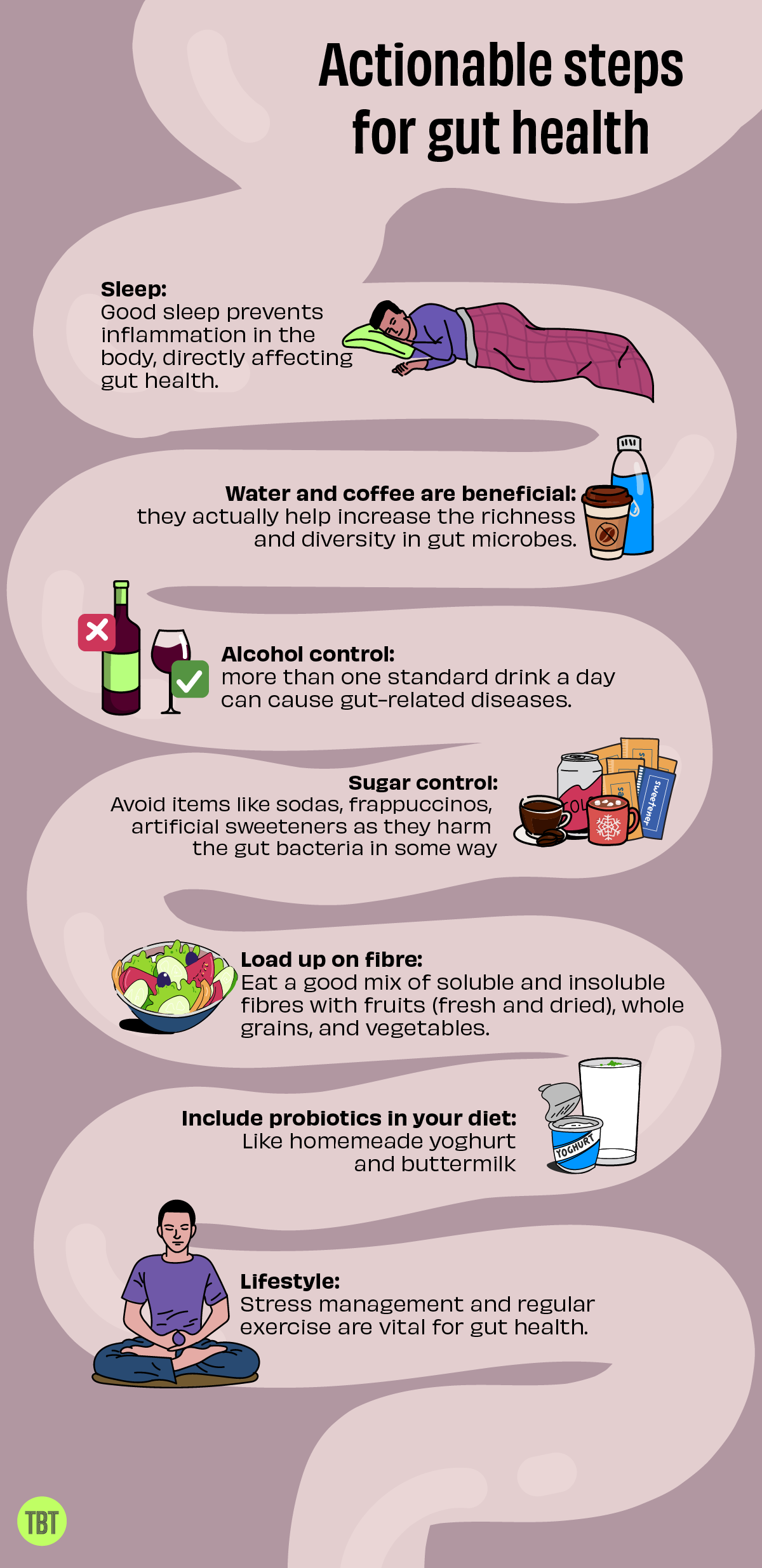The ultimate guide to achieve good gut health
The most trustworthy source of food and
fitness journalism in the country.
Editor’s note: Back in May, I wrote an article introducing the idea of gut health and promised a follow-up guide for more actionable steps. That’s the piece today, from Sandesh Chopade, a bioengineer trained at IIT Kanpur and University College London, and now director of Nashik-based Genetic Health and Research Centre. I hope this is helpful. If you have specific followup questions, do email us, and we will try to answer. — Samarth Bansal
We introduced the concept of gut health in a previous TBT piece. For a solid foundation, I recommend reading that first. However, here’s a quick refresher to enhance your understanding of this guide:
1) Gut Composition: The gut, comprising the stomach, small intestine, and large intestine, houses 90% of the microbes in our body. This collection of microorganisms is known as the gut microbiome. (Fun fact: Your body contains more microbes than human cells, with a ratio of at least 10:1).
2) Gut’s broader role: The gut isn’t just a digestion centre; it’s increasingly recognized as the core of our overall health. Current research indicates that these tiny organisms influence our immune system, mood, and even our weight.
3) Microbes – good and bad: To understand gut health, we need to shift our perception of microbes. Not all are harmful; many are beneficial. The key is balancing the good and bad bacteria in our bodies. This balance is what we call ‘gut health’— and an imbalance can lead to various issues, including digestive disturbances, inflammation, and mental health challenges.
Today, we dive into an actionable guide for maintaining and improving your gut health, divided into two main sections: (a) understanding probiotics and prebiotics, and (b) simple, mostly diet-related tips for a healthy gut.
I. What are probiotics and prebiotics?
Probiotic and prebiotic products line the shelves of most grocery stores. The labels promise to help with a range of health issues like indigestion, constipation, and immune disorders.
So, what exactly are they? Think of them as helpers for your digestive system.
Probiotics are good bacteria, like the ones already in your gut. These tiny helpers, which are live microbes such as bacteria and yeast, can be found in yoghurt, raw cheese, kombucha, apple cider vinegar, and kimchi. They move into your digestive system and work to keep it healthy.
Prebiotics, on the other hand, are the food for these good bacteria. They are non-digestible compounds, often plant fibres, that selectively encourage the growth of beneficial microbes. Foods like garlic, onions, asparagus, bananas, oats, apples, and flax seeds are rich in prebiotics. Some can also be found in animal products, such as oligosaccharides in breast milk and honey.

Probiotics and prebiotics help your digestive system
If you’re at a supermarket right now, you might be overwhelmed by the choices in pro/prebiotic products. Should you pick kombucha or Greek yoghurt? Maybe both and consume them in a single sitting? And what about kefir? Of course, how can you forget the weekly health column suggested adding sauerkraut or kimchi to your lunch.
So how do you choose your probiotics? It can be a bit confusing, so here are some simple tips:
1. Probiotic quality: First, check if the product is a good probiotic. Two key metrics are the types of bacteria in it and how many live bacteria it contains.
a) Strain specificity: Different strains of probiotics, which refer to specific ‘versions’ of bacteria, offer varying health benefits. Some strains might be better for digestion, while others could be more effective for immune support. Look for products containing well-researched strains known to address your specific health concerns.`
For example, yoghurt and curd: Both are fermented dairy products enriched with beneficial probiotics. Yoghurt is a creamy, tangy dairy product made by adding special bacteria to milk, resulting in a firmer texture, whereas curd is a homemade dairy product with a gentler taste, typically softer and less consistent in texture, created by mixing a little bit of existing curd into milk.
So, while curd can contain probiotics, the types of bacteria and their concentration can significantly differ due to variations in preparation methods and starter cultures. This variation makes curd less consistent as a probiotic source compared to yoghurt, whose production is more standardised, especially in commercial settings. (Watch out for the added sugars, though!)
While there are many beneficial bacteria that contribute to gut health, Lactobacillus and Bifidobacterium are particularly noteworthy. These groups stand out due to their widespread presence in the human gut, their diverse and well-researched health benefits, and their effectiveness in probiotic formulations.
Lactobacillus: These bacteria, found in yoghurt and fermented foods, are good for general digestive health. They aid the immune system in treating gastrointestinal infections and disorders.
Bifidobacterium: These are commonly found in our intestines and are known for supporting gut health. They help in breaking down fibre, protecting against harmful bacteria, and boosting the immune system, essential for overall health and digestion.
b) CFU Count (Colony-Forming Units): This measures the amount of live bacteria in a product. A higher CFU count generally means the probiotic is more effective. Look for this count on the product label. While there’s no one-size-fits-all number, many probiotic supplements contain between 1 billion to 10 billion CFUs per dose. However, certain health conditions might benefit from higher or lower counts.
Note that the CFU count listed on the label is often the count at the time of manufacturing. It’s important to check if the product guarantees this count until its expiration date, as some probiotics might lose potency over time.
🧉Yogurta share this with your fam 😉
2. Delivery system: Probiotics come in different forms, and how you take them can make a difference.
a) Foods: As mentioned before, many probiotics are found in fermented foods like yoghurt, kefir, sauerkraut, and kimchi. These are natural sources and are often easily absorbed by the body.
b) Supplements (pills, powders, syrups): These forms usually have higher concentrations of probiotics, with specific strains and high CFU counts. They can be a good choice if you’re looking for a particular strain or need a higher dose. However, their effectiveness can vary from person to person.
While supplements offer convenience and specificity, probiotics from natural food sources may be more effective for most people. One reason is that food provides a protective environment for the probiotics, aiding their survival through the digestive system.
3. Adulteration and additives: A big problem with many ready-made probiotic foods and drinks is the many additives they contain. These products should boost gut health by adding healthy bacteria in our gut.
However, if they have a lot of added sugar or artificial sweeteners, they can actually harm your gut health. It’s important to remember that beneficial bacteria need a good environment to thrive — unfortunately, added sugars don’t provide that environment.

Choose your ready-made probiotics carefully
Cost considerations: Cost is undoubtedly a significant factor, especially if you’re planning to include probiotics in your diet long-term. While you can readily purchase high-quality probiotics like kimchi and kombucha from stores, making them at home can be a cost-effective and rewarding alternative. Homemade probiotics not only save money but also allow you to control the ingredients, avoiding unwanted additives. With a bit of patience and some basic preparation, you can create these probiotic-rich foods yourself.
Risks: It’s important to be aware of the potential risks associated with consuming probiotics. These products contain foreign microbes that, under certain conditions, could cause health issues.
• People with weakened immune systems or those suffering from severe illnesses should be particularly cautious, as these microbes can sometimes become pathogenic, leading to infections. For this reason, it is important to consult a physician about which probiotics might be suitable for you, especially if you feel unwell on consumption of a particular brand of probiotics.
• There is a lack of long-term research on their potential downsides. Despite this, probiotics have been safely used by many healthy individuals.
However, one of the biggest risks comes from unapproved, off-the-shelf probiotics, which may contain unlisted or harmful microbes. Such contamination poses serious health risks, emphasising the need for careful selection and use of probiotic products.
Share because we haven’t cracked the “trust your gut” joke 😝
II. Actionable steps for gut health
Improving and maintaining gut health is simpler than you might think. It does require a holistic approach rather than a strict ‘eat this, avoid that’ checklist.
Here are some crucial considerations for better gut health:
1. Sleep: Although not immediately apparent, good sleep is the number one reason for a healthy gut. Think back to those days when you slept less than five hours, woke up feeling groggy with a headache, and had an uneasy gut. Insufficient sleep triggers inflammation in the body, directly affecting gut health.
2. Diet: The gut’s primary function is nutrient absorption, so diet plays a big role. I have filtered through scores of diet guidelines, and here’s a condensed guide for a healthy gut.
• Sugar control: Avoid soda entirely if possible. Those frappuccinos from Starbucks your favourite coffee shop are just as bad. And sorry, but aspartame substitutes won’t help either: all the six FDA approved artificial sweeteners harm the gut bacteria in some way.
• Alcohol control: Excessive alcohol consumption—more than one standard drink a day—can cause gut-related diseases.
• Load up on fibre: Make sure you get a good mix of soluble and insoluble fibres with fruits (fresh and dried), whole grains, and vegetables. An easy way of designing your menu for the day is by including vegetables of every colour in the rainbow. Polyphenols in colourful plant produce are known to help gut health.
• Eat foods high in omega-3 fatty acids: Fish oil supplements and flax seeds have been extensively studied for their health benefits, and reducing inflammation in the gut is one of them.
• Include probiotics in your diet: As suggested earlier, it is best to stick with homemade fermented food such as yoghurt and buttermilk. Avoid adding sugar to these for the most benefit.
• Water and coffee are good. Recent research has indicated that long-term consumption of caffeine within the recommended levels (read previous TBT piece for details) can actually help increase the richness and diversity in gut microbes. And I don’t need to tell you to drink enough water: if you’re not consuming 3 litres a day already, just ignore everything until this point and do that first.
3. Lifestyle: Stress management and regular exercise are vital for gut health. Keeping stress at bay and maintaining an active lifestyle will support your gut in the long run.
That’s about it.

Did you know that you can support both your gut and Truth Be Told 😝
